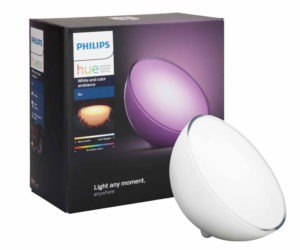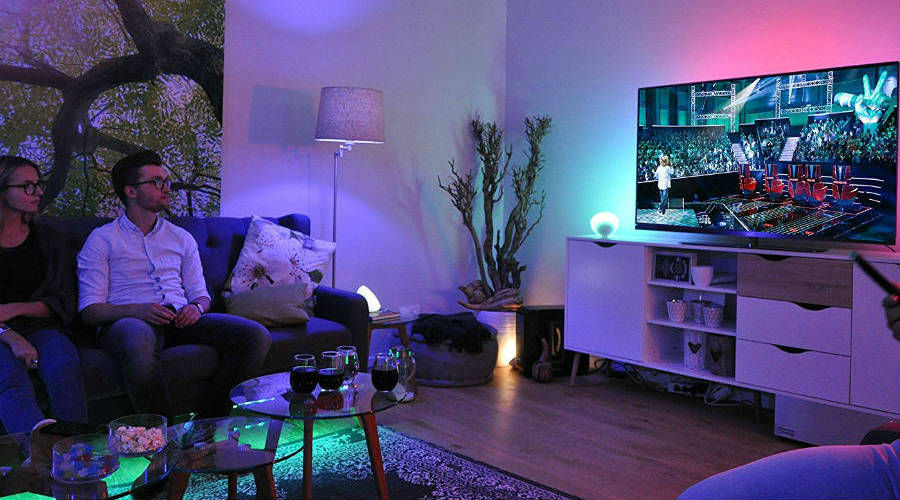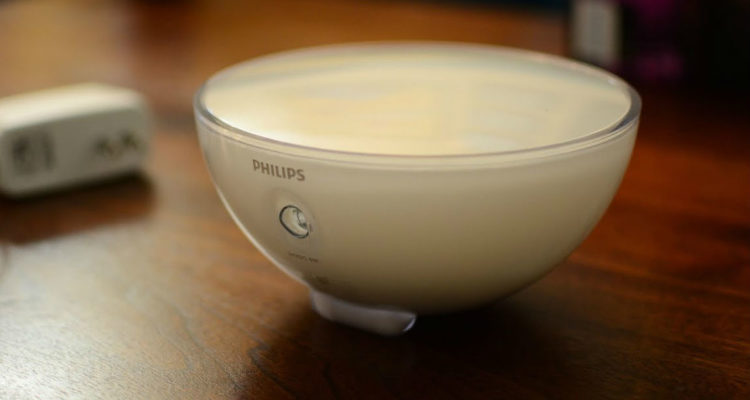Portable lights always seem to have problems. Some come in under-powered while others don’t provide much illumination time off the charger. They can look clunky and don’t offer a lot of options. But Philips has broken the mold with their Hue Go portable light. This compact device features an innovative design, vibrant color, and a ton of bonus features (if you have a Hue Bridge).
The Hue Go retails for $80, which is a little high for a portable light. The device features a rechargeable battery that can give you up to 2 hours of use in the best conditions. It can also be plugged directly into a wall outlet.
Love the minimalist design
The saying “less is more” is proven true with the Hue Go design. Shaped like a semi-sphere, it has a clear frosted exterior that allows light to shine from all sides. The flat side has a slight convex curve to help push the light out in all directions. A small notch protrudes out the back to allow it to sit upright. That position feels a flimsy and may roll to the side if bumped. You can fit the entire unit in the palm of your hand.
On the back is a single button that controls all the manual functionality of the device. Pushing the button will turn it on and allow you to cycle through the 7 lighting presets. Double tapping and holding the button lets you cycle through the colors. And holding down the button for 2 seconds will put it into sleep mode. This is surprisingly intuitive for single button control.
A power cord can connect to the back for recharging and running off an outlet. The cord Philips provides is extra long with a transformer at the end. Removing the plug can be a pain if you have larger hands, but is just a minor annoyance.
For the most part, I love the minimalist design and how it functions. But there are some limitations with use. The Philips Hue Go is not a heavy-duty product. It is fine for home and some outdoor use, but isn’t designed to take much abuse. The shell will crack if dropped on a hard surface and it is not waterproof (it is however built to withstand high humidity levels). So think twice if you plan on using this on your neck rock climbing excursion.
Does not need a Philips Hue Bridge
Using the Hue Go does not require being part of the Philips Hue ecosystem. It doesn’t even require connecting to the internet or your phone. Simply charge it up and get start using it like any other “dumb” light.
With that said, the value is with the integration to your existing Philips bridge. This gives you control through the app on your phone to change the color, brightness, and temperature. Philips boasts a whopping 16 million color combinations. There are the other standard functions in the Hue app such as scheduling, timers, and alarm. I even got it to work with the Hue Disco app to sync it to some music.
Smart Compatibility
If you have a Hue Bridge, you will get all the smart home compatibility you find from other Philips Hue products. Voice commands work with Amazon Alexa, Google Assistant, Microsoft Cortana and Siri through Apple HomeKit. They allow you to turn on and off the Go (as long as it is in standby mode), change colors, and dim.
Philips has an impressive compatibility list. Their bridge works with Nest, IFTTT, Logitech, Samsung SmartThings, Razer, and a slew of others. They are arguably the most connected brand in the smart home industry.
Battery life and charging
For portable use, the battery might be the most important aspect of the device. Philips states you can get around 3 hours of use off the charger. I’d put that closer to 2 hours with the best possible circumstances. This drops dramatically if you’re using it on brighter settings. The light operates at a maximum 40% brightness on battery to conserve power. This felt like a concern at first, but at 40% I was surprised how bright it still was.
When you’re done using the light, you can turn it to standby mode. This limits the power usage and will stay active for 2 hours before fully shutting down. Standby mode allows you to activate the Hue Go from your phone while it is off. If the device is plugged in, it will always remain in standby mode when off.
Charging up to a full battery takes around 90 minutes. There is unfortunately nothing to tell you what percent is left during use. Another gripe is the battery can’t be replaced (at least not easily). It would be nice to have an option to swap in a more powerful Li-ion battery. So while the LED gives you an estimated 20,000 hours of use, the portable lifespan is limited to how long the rechargeable battery lasts.
How bright is the Hue Go?
Using a Kill-a-Watt, the light draws 6 watts of power in use. This is the equivalent of a 40 watt incandescent bulb inside. It does a terrific job of making the most out of the LED and I am impressed with the illumination. Still, I wouldn’t count on this being the primary light in a room. It is much more suited to accent something in the room.
The colors are incredibly sharp in use. Similar to the high quality found with other Hue bulbs. They don’t wash out as the brightness diminishes. Even tough to mimic colors like blue, green, and purple look terrific.

Conclusion
This is definitely a “want” household item more than a “need”. Still, I’ve found it worth the cost. It has primarily remained in the office on a plug. I’ve set up some fun functions like having the light turn blue when it starts to rain. Over the Summer, I plan to use it off the charger on the porch at night. And if there is a power outage, I’ve got a way to keep my room lit for an hour or so.
The $80 price tag seems a tad high for a portable. But the more I’ve used it, the more I’m sold on it’s value. The caveat is that you already have a Hue Bridge in the home. If you do, this is a fun accessory to liven up a room.


